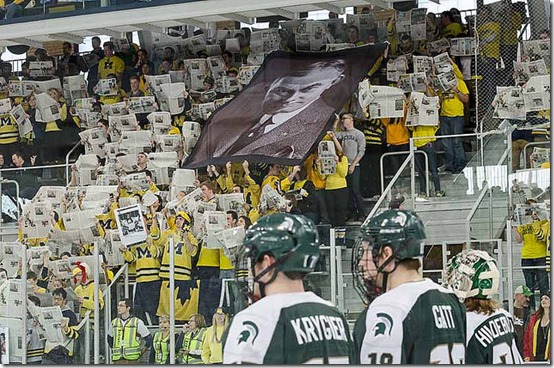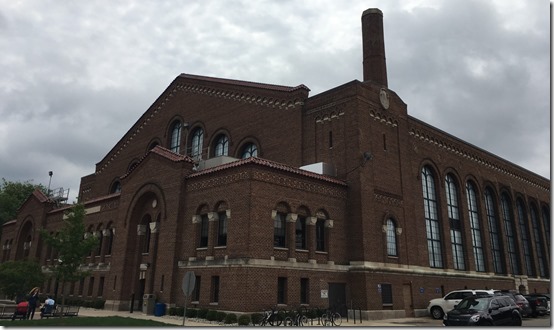yost is not nam there are rules

If there is a broad consensus still left in America today, it is that drugs are bad. Nancy Regan told me this, but so has Darren Aronofsky. Richard Nixon. TLC. Kermit the Frog. An egg cooking in a pan. Breaking Bad. All vehemently anti-drugs. The Wire—surely the last American institution to command broad trust—was about how many things were bad, and drugs were certainly one of them. Drugs: nope. They're bad.
But the first period of Saturday's hockey game asks a provocative question. What if… what if drugs are good? Because that game was on drugs. And it was good.
By the end of one period of hockey folks in Yost Ice Arena had seen 34 shots, seven goals, eight penalties, two majors, and one game misconduct in a pear tree. Last week I wrote about how Old Yost felt, and Wisconsin came in like Northern Michigan or Lake State of old, leading with the jaw and throwing haymakers. They got blitzed on Friday, got pissed Friday night, and came into the Saturday game looking for any excuse to get out some frustrations.
They did not come into that game with any plan to prevent Michigan from scoring buckets of goals. God bless Tony Granato, who recruits a boatload of talent and then declines to put it in any sort of "system" that could "prevent scoring chances." That's my kind of opposing coach. Vague threat from the legion of skilled guys on the opposition, no ability to turn that into winning hockey. Has a guy who sounds like a Pokemon scoring bunches of goals. A+, it is deeply unfortunate he's getting fired into the earth's mantle the instant the season ends.
[After THE JUMP: did you know the 2007 film Bucket List popularized the term "bucket list"?]
Previously: Part one
[Bill Rapai]
The time blocked out on Red Berenson’s schedule for handing out free tickets could be reallocated to recruiting by 1993. Michigan had won or tied 56 of their last 62 home games by the beginning of the 1993-94 season, was riding a three-year NCAA Tournament streak, and had finished no worse than second in the CCHA each of the past three seasons.
The success of the team fueled Yost’s atmosphere, and the atmosphere helped reel in recruits; Michigan’s 1993 recruiting class featured future Hobey Baker winner Brendan Morrison as well as John Madden, Jason Botterill, Mike Legg, and Warren Luhning. The recruiting success continued in 1994, as Berenson signed Marty Turco, Bill Muckalt, and Matt Herr. Stories of Yost’s unmatched gameday environment spread by word of mouth and students were soon filling the entire east side of Yost. The means for procuring tickets changed drastically as the one-time Diag freebie became one of the hottest tickets in town; students camped out as more highly-touted recruits came in.
Brendan Morrison, forward (1993-97): My freshman year we had a great team and were competing for the national championship and every single night we went into that arena and played at home it was sold out and the students led the charge. You look at the architecture of the rink and you read about the history of the field house and how it evolved over the years to where it is now or where it was my senior year— I remember students would sleep outside the Michigan Union there for two nights in order to get season tickets. When you walked by there as a player and you saw the commitment that your fellow students were willing to make in order to come and watch your team play, it was truly a special thing to be able to go out there and play in front of them and it really made you understand how special a place Yost is.
Roger Spurgeon, student season ticket holder: I met these guys and we made friendships our freshman year, so our sophomore year I wouldn’t be surprised if it was me who said, “Hey, let’s go get season tickets.” They sold them at the Union and I don’t think we actually camped out. I think we went there at maybe 6 AM.
Scott Spooner, student season ticket holder: Yeah, I think the first year we were like “Let’s get there early” so we got there at like 6 AM.
Spurgeon: Yeah, like 6 AM, and there were maybe 50 people in front of us. I kind of remember that season tickets were about $60 and we got a free hockey jersey. It had “Subway” written on the back. It was a cheap reproduction hockey jersey, it wasn’t anything fancy. I think the next couple years they gave us sweatshirts. Like, nice sweatshirts as incentives to buy season tickets.
Spooner: That still said “Subway” on the back.
Spurgeon: We didn’t care. We got freebies, so we didn’t care if it said “Subway” or not.
Megaphone Man, student season ticket holder: Demand was high. You got a season sweatshirt when you camped out and put in your order for tickets. I remember they were sponsored by Subway, so they were kind of like a must-have item, kind of like they do with the football shirts and the Maize Rage shirts. Before they started doing it on a regular basis for the other sports, I think hockey was the only one really doing it at the time.
[After THE JUMP: fandom expands, everyone dances, and the rules of the rule-free student section]
[Editor's note: If you've wondered where Adam's been this summer, he's been working on this. We did not feel we could let the Red Berenson era end without doing it justice, and this is our attempt. Enjoy. –BC]
It’s the roof. It has to be the roof. Yost Ice Arena, née Yost Fieldhouse, wasn’t made for hockey, but stand outside and look up and it’s impossible not to feel like it’s a relative of an Original Six building, perhaps the Montreal Forum’s cousin or the sibling of the Olympia in Detroit. No, it wasn’t built for hockey. At its core, Yost is just a big brick barn; it’s the people inside that made the barn a rink and made the rink one of the most maddening, intimidating places for opponents to play hockey in North America. The sharp wit of the crowd, the perfect pep band, the waves of sound that crawled the walls, crested at the ceiling, and crashed to the ice were staples of Yost throughout the 1990s. Getting there, though, might not have happened if not for a chance encounter with a bunch of Bears.
---------------------------------------------
 Sponsor Note: this post made possible by our continued partnership with Homesure Lending. If you're in need of a mortgage, Matt will collect your information quickly, check several different mortgage companies for the best possible rate, and pass it along to you. Then you get a house. Or a houseboat, I guess? Don't buy a houseboat, that's my advice to you.
Sponsor Note: this post made possible by our continued partnership with Homesure Lending. If you're in need of a mortgage, Matt will collect your information quickly, check several different mortgage companies for the best possible rate, and pass it along to you. Then you get a house. Or a houseboat, I guess? Don't buy a houseboat, that's my advice to you.
Well fine, then. Be like that. Buy a dang houseboat. See if I care. –BC
---------------------------------------------
An Empty Barn
Red Berenson, head coach: It was disappointing [when I first arrived] from the standpoint that our team wasn’t very good and the image of the program wasn’t very good, so the fans were really— they weren’t there very often. When we played Michigan State was the only time we had a full building, and there were more green and white people there than there were Michigan people. So, it was hard to recruit good players to come here and then see that we weren’t getting the support from our fans, but we were all confident that when our team got better that they would come.
But we had to do some things away from the rink, too, and I think we did a good job. We got our players to go up and visit fraternities and sororities, we got the ticket office to take season tickets and particularly Michigan State tickets— those seemed to be the hottest ticket— up to the Diag and interact with the students; the same thing in the dorm. I constantly was on the move around town giving away tickets, trying to get people to come to the game, and just telling them “If you like it, I guarantee you you’ll want to buy a ticket next time.”
Mel Pearson, assistant coach: It was interesting. When I first got here one of the first things that happened to me was that I was given 400 tickets to give away for every game, which I found...odd. We had trouble putting people in the building. Then obviously when I left here later on I could hardly get four tickets for my family, so things really evolved.
The first few years I think we had to change the culture here, change the atmosphere. Coach Berenson brought an exciting brand of hockey. He would always say he wanted to play like the Montreal Canadiens in the ’70s and the Edmonton Oilers in the ’80s; upbeat-type teams. I think that really transformed the whole atmosphere in Yost.
Berenson: The building was never intended to be a hockey rink. It was built as an indoor field house, the first of its kind, but when Don Canham built Crisler for basketball and they moved basketball out of Yost, I don’t know whose idea it was to put hockey in Yost— or to try it— but they did it and from the old Coliseum over by Fingerle Lumber, well, that’s where I played. In fact, I lived just down the street from there at 424 South Hill Street my last two years here. So, I’d just walk to the rink. I could see people lining up all the way down nearly to our house before the games.
But anyway, when I came back it was disappointing, the support and the image of the program and so on wasn’t very good, but then it slowly changed. Even in the building I thought our administration and building management— I think it was Wilf Martin at the time and Mark Renfrew and we recognized that we needed to spruce up the building, so we did that slowly. We filled in underneath the bleachers, for example, and we added some storage areas and we didn’t put up new boards but we put up new signage and we got new nets, and slowly the rink started to look a little better. We cleaned up the lobbies and we tried to improve the lightning.
Well, it wasn’t until ’96 that we did any kind of a serious renovation, but we were doing something every year, so I felt better that the building was more acceptable. I think there was a time where Canham took all the mirrors out of the ladies’ washrooms in football— I don’t think we did that in Yost— because of the ladies taking too much time and then creating lineups. We didn’t have that problem at Yost, but we tried to make it fan friendly, but you still had to win. But you didn’t want people coming to a dirty rink or sticky seats, little things like that, so that’s what it was like. We had our moments of glory in that building, but the fans didn’t get to see much of them. Slowly they started to come.
[After THE JUMP: Kent Brothers’ speech, the legend of the Doughboy, and how Yost boosted recruiting (for Michigan and opponents)]


36